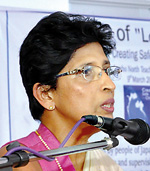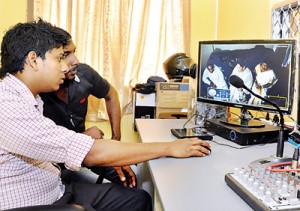News
Where abuse ends and healing begins
A dream has become a reality and the simple but important dream was to set up a place where “abuse ends and healing begins” for all those traumatised and victimised children out there.

Prof. Asvini D. Fernando
It was on the humid morning of last Monday that ‘Lama Piyasa’ was ceremonially opened at the Ragama Rehabilitation Hospital amidst a distinguished gathering. Set amidst the sprawling and tranquil acreage of the Ragama Rehabilitation Hospital, ‘Lama Piyasa’ occupies its very own niche under a spreading flamboyant. A pleasing green has been the choice for the exterior of this haven, blending well with the large shady trees and grass covered slopes around it, while the interior walls are a sunny yellow interspersed with cartoon figures, uplifting the spirits of anyone who walks in.
The invitees see for themselves that thought has been given to every minute detail, with even the bed-spreads in the ward having nursery-rhyme patterns. Among those present at the ceremony were retired Supreme Court Judge Justice Shiranee Tilakawardane; Member of Parliament Sudharshani Fernandopulle; Colombo North (Ragama) Teaching Hospital Director, Dr. U.M.M. Samaranayake; Plan Sri Lanka Country Director, Supriyanto Supriyanto; and Colombo Metropolitan Rotary Club President Kumar Mirchandani.

The unobtrusive video-recording unit attached to the room where the child’s evidence would be taken. Pix by Indika Handuwala
It is with much emotion that the ‘mover and shaker’ behind the setting up of ‘Lama Piyasa’, Prof. Asvini D. Fernando, describes how the dream came about.
“Her eyes say it all. There is only ‘frozen’ watchfulness,” says Prof. Fernando, referring to a little girl who has just been brought to her ward at the Colombo North Teaching Hospital, with multiple burn injuries as well as layers of dirt, not having been allowed to bathe for a long time. This was typical of the numerous abused children that she has treated and these haunting images had propelled her and her team towards doing something tangible for them.
Victims like this spurred the conceptualisation of ‘Creating Safe Communities for Children’, points out Prof. Fernando, the Chairperson of the Child Protection Committee of the Sri Lanka College of Paediatricians (SLCP), adding that child abuse and neglect are being reported from all parts of the country at an alarmingly increasing rate.
“Data from the Women’s and Children’s Bureau of the Police and hospital-based data corroborate this fact. Hence there was a need within the country for all stakeholders to unite to formulate an effective response when an incident is reported. There was also a need to plan out an effective campaign to prevent child abuse and neglect,” she explains.
Realising the urgent need, the SLCP’s Child Protection Committee together with Plan Sri Lanka embarked on the two-pronged ‘Creating Safe Communities for Children’ project, the Sunday Times learns which included better management of victims as well as prevention of child abuse and neglect.

From left Health Services Director-General Dr. Palitha Mahipala; Health Minister Dr. Rajitha Senaratne; Rosy Senanayake, State Minister for Child Development,; Pearl Weerasinghe, Secretary to the State Minister for Health; Prof. Asvini D. Fernando, the Chairperson of the Child Protection Committee of the Sri Lanka College of Paediatricians; and Plan Sri Lanka Country Director Supriyanto Supriyanto, at the opening of ‘Lama Piyasa’
The management of victims of child abuse and neglect is essentially multi-sectoral, said Prof. Fernando, adding that the SLCP and Plan Sri Lanka invited all stake-holders to several workshops and meetings to develop a guideline. Those involved were the College of Forensic Pathologists of Sri Lanka; the Sri Lanka College of Psychiatrists; the Medico-Legal Society of Sri Lanka; the Child Development and Women’s Affairs Ministry; the National Child Protection Authority; the Probation and Child-care Services Department; the Justice Ministry; the Attorney General’s Department; the Women’s and Children’s Bureau of the Police; and the Education Ministry.
The final document titled ‘National Guideline for the Management of Child Abuse and Neglect: A Multi-sectoral Approach’ was launched by the then Health Minister Maithripala Sirisena on December 4, 2013, at the BMICH and a pilot project launched on September 25, 2014, in the Gampaha district to introduce the guideline to doctors in the area. The National Guideline has now been translated into Sinhala and Tamil and is to be printed shortly and distributed to other stakeholders such as probation officers and police, it is learnt.A major issue, meanwhile, in dealing with victims of child abuse and neglect in health institutions was confidentiality and sensitive management not only of the victims but also their families, according to Prof. Fernando.Detailing the current scenario, she says that victims are admitted to different wards in health institutions. Some pregnant teenagers are admitted to gynaecology wards as they cannot be in the paediatric wards. This leads to several issues for the children as they are housed in adult wards.
It was during the formulation of the Guideline that the need for a facility to admit all child victims (0-18 years), until their immediate needs are sorted out and further management planned, came to the forefront, the Sunday Times understands.
| Facilities to help victims overcome their trauma Like the lotus bud that is conceived and lives in the mud but rises to blossom without the mud sticking onto its tender petals, the fervent hope is that ‘Lama Piyasa’ will help abused children to rise above their trauma. It is to provide much-needed support that ‘Lama Piyasa’ comprises facilities for the in-house management of abused children; a state-of-the-art video-recording unit and long-term follow-up of victims. It is the ‘best interest’ of the child that has been considered. The first and obvious is the area where child victims will be provided multi-sectoral attention for their medical and other needs. Prof. Fernando says that the Attorney General’s Department inspected the unit during the building process and its suggestions have been incorporated. It was set up with invaluable support from the Rotary Club of Colombo Metropolitan. The National Child Protection Authority has agreed to partner with the Consultants of the Colombo North Teaching Hospital to ensure that the unit functions well. Last but not least will be the essential long term follow-up of these children, she says, recounting the tragic case of a 14-year-old girl who took her own life even though she had had short-term rehabilitation which had obviously been inadequate. |
The Health Ministry accepted the concept of ‘Safe Houses’ in health institutions throughout the country and the SLCP and Plan Sri Lanka together with Dr. Roy Perera, the then Director of the Colombo North Teaching Hospital, with the approval of the then Health Ministry Secretary Dr. Nihal Jayathilaka, designed a safe house, recalls Prof. Fernando. This was ‘Lama Piyasa’ and with Health Ministry approval, the foundation stone was laid on November 27, 2013, at the Ragama Rehabilitation Hospital.
Referring to the second prong of preventing child abuse and neglect, she said that ‘A Project for the Protection of Children from Abuse, Exploitation, Violence and Neglect’ was also designed.
With the SLCP’s Child Protection Committee compiling the booklet, ‘Let’s protect our children from abuse and neglect’ and Airtel sponsoring its printing as part of its corporate social responsibility (CSR), it was officially launched at the college’s annual academic sessions in August 2012. The booklet which has now been translated into Sinhala and Tamil has been distributed in several areas.
Posters with key messages for both parents and children on the prevention of child abuse and neglect had also been designed by the Child Protection Committee. GlaxoSmithKline, as part of its CSR undertook the task of printing and distributing these posters to schools, hospitals and police stations throughout the country. The poster-launch coincided the initiation of the ‘Creating Safe Communities for Children’ project.
| Urgent needs will be met: Health Minister A strong promise was delivered by Health Minister Dr. Rajitha Senaratne after an impassioned plea by Prof. Asvini Fernando. “We will give priority to meeting the urgent needs of ‘Lama Piyasa’,” assured the Minister, while also asking Dr. Palitha Mahipala, Director-General of Health Services, to draw up plans to set up similar institutions with a multi-disciplinary approach in every province. The needs of ‘Lama Piyasa’ as lobbied for by Prof. Fernando are staff including medical officers, nurses, minor staff and also female security staff. Presently, the Ragama Medical Faculty Dean Prof. Nilanthi de Silva has allocated a demonstrator to act as coordinator. It is in response to a request by Rosy Senanayake, the State Minister for Child Development that Minister Senaratne assured the setting up of institutions similar to ‘Lama Piyasa’ in every province. |

